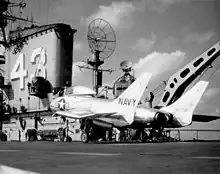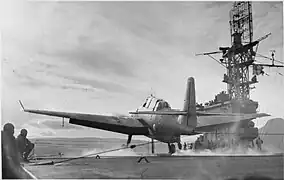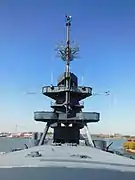SK radar
SK was an American-made air-search radar used during World War II by the United States Navy. Models included SK-1, SK-2 and SK-3.[2]
_1944.jpg.webp) SK-1 aboard USS Long Island | |
| Country of origin | United States |
|---|---|
| Manufacturer | General Electric |
| Introduced | 1944 |
| Type | Air-search radar |
| Frequency | VHF band |
| Beamwidth | 10° |
| Pulsewidth | 5 μs |
| Range | 160.9 km (86.9 nmi) |
| Azimuth | ± 3 ° |
| Precision | ± 100 yd (91 m) |
| Power | 250 kW[1] |
Overview
SK was a long wave search set for large ships. It furnished range and bearing of surface vessels and aircraft, and it could be used for control of interception. The set had both "A" and PPI scopes, provisions for operating with remote PPIs and for IFF connections, and built-in BL and BI antennas.[3]
With the antenna at 100 ft (30 m), SK could detect medium bombers at 1,000 ft (300 m) altitude at 100 miles (160 km). Range accuracy was ± 100 yards (91 m) and azimuth accuracy ± 3°. There was no elevation control, but elevation could be estimated roughly from positions of maximum and minimum signal strength.[3]
Shipment for SK included spares, with tubes for 400 hours, and a separate generator if the ship's power is DC. SK was not air transportable.
SK had 10 components weighing approximately 5,000 lb (2,300 kg). The heaviest unit, at 2,400 lb (1,100 kg), was the antenna assembly. The antenna measured 15 ft (4.6 m) x 16 ft 9 in (5.11 m). It was mounted 100 ft (30 m) or more above water. The minimum operators required were one per shift. Primary power required was 3500 kilowatts, 115 volts, 60 Hz. The source of power is ship's power of 115 volts, 60 Hz.[3]
During the later stages of World War II, a parabolic antenna called SK-2 replaced the SK-1.[1]
On board ships
 United States
United States
- Midway-class aircraft carrier
 SK-2 aboard USS Coral Sea
SK-2 aboard USS Coral Sea - Essex-class aircraft carrier
- Independence-class aircraft carrier
- USS Enterprise (CV-6)
- USS Saratoga (CV-3)
- Casablanca-class escort carrier
- Bogue-class escort carrier
- Iowa-class battleship
_at_anchor_in_1944.jpeg.webp) SK-1 aboard USS Honolulu
SK-1 aboard USS Honolulu - South Dakota-class battleship
- North Carolina-class battleship
- Colorado-class battleship
- Tennessee-class battleship
- USS Pennsylvania (BB-38)
- Nevada-class battleship
_steaming_off_Portland%252C_Maine_(USA)%252C_on_9_May_1945_(NH_97932).jpg.webp) SK-1 aboard USS Augusta
SK-1 aboard USS Augusta - New York-class battleship
- USS Arkansas (BB-33)
- Alaska-class cruiser
- Des Moines-class cruiser
- Oregon City-class cruiser
- Baltimore-class cruiser
- USS Wichita (CA-45)
- Fargo-class cruiser
- Cleveland-class cruiser
- New Orleans-class cruiser
- Brooklyn-class cruiser
- Portland-class cruiser
- Northampton-class cruiser
- Pensacola-class cruiser
- Omaha-class cruiser
- Currituck-class seaplane tender
- Appalachian-class command ship
- Mount McKinley-class command ship
 United Kingdom
United Kingdom
Gallery
 SK-1 aboard HMS Trumpeter
SK-1 aboard HMS Trumpeter SK-1 aboard USS Texas
SK-1 aboard USS Texas_underway_in_the_Central_Pacific_on_2_May_1944.jpg.webp) SK-1 aboard USS Wichita
SK-1 aboard USS Wichita.jpg.webp) SK-2 aboard USS Alabama
SK-2 aboard USS Alabama_underway_off_the_Philadelphia_Navy_Yard_on_29_October_1946.jpg.webp) SK-2 aboard USS Macon
SK-2 aboard USS Macon_in_1952.jpg.webp) SK-3 aboard USS Princeton
SK-3 aboard USS Princeton
Citations
- "Radar Equipment of World War II". NavWeaps.
- Robert, Buderi (1998). The Invention That Changed the World: How a Small Group of Radar Pioneers Won the Second World War and Launched a Technical Revolution. Touchstone. ISBN 0684835290.
- "US Radar: Operational Characteristics of Radar Classified by Tactical Application". public2.nhhcaws.local. Retrieved 2022-02-18.
References
- Norman Friedman (2006). The Naval Institute Guide to World Naval Weapon Systems. Naval Institute Press. ISBN 978-1-55750-262-9
- Buderi, Robert (1998). The Invention That Changed the World: How a Small Group of Radar Pioneers Won the Second World War and Launched a Technical Revolution. Touchstone. ISBN 0-684-83529-0
- Hezlet, Arthur (1975). Electronics and Sea Power. New York: Stein and Day. ISBN 0-8128-1811-3